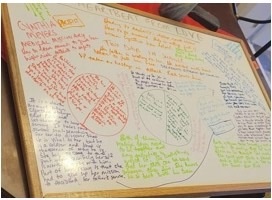by Hallee Bridgeman, @halleeb

I am in the process of writing three books that are due to my publisher on September 1st. I finished book 1 on February 4th, spent the next couple of days working on the characters for book 2, then sat down and put together my story.
I write Christian romantic suspense, so inside that genre, I need to have a faith arc, a romantic arc, and a suspense arc. Each of those arcs require internal and external conflicts, motivations, and different characterizations.
When I’m setting up and getting ready to plot a book, the first thing (other than my characters) that I need to know are what those conflicts and motivations are, and how they’re going to be resolved/utilized.
I take a large white board and write my female protagonist’s name across the top on one side, and my male protagonist’s name across the top on the other.
Each arc has a different marker color. Here is where I plot out the three different story arcs, motivations, and conflicts. I also determine what will resolve those conflicts, how each arc will climax, and how the characters’ motivations will flow and ebb with the story.
If you’d like to see a 24-second time-lapsed video of the process you can view it here: https://www.facebook.com/192799110825012/videos/214366240375109
A final product looks like this photo:


Once I have that finished white board, I set up a chapter-by-chapter brief outline. Basically, it’s, “In this chapter, this happens.” Then I’m ready to write.
As I sat down to write this particular book, I realized I needed to do the characterization one more time. This story is about an FBI agent who is working with a special forces A-Team in a joint operation to uncover an eco-terrorist organization. I realized that before I could write this book, I needed to break down my organization the same way I broke down those characters. I didn’t use a white board this time; just the pages of a notebook. Here is what that looked like:
Like the characters, I needed motivations, organization, purpose, and eventual demise.
We all create with different brains, and different creative processes appeal to people in distinctive ways. It took me a few years of just letting my creativity flow to understand that my way of creating characters (and apparently terrorist organizations) can feel or look a little chaotic to someone who doesn’t create the same way as me – and that’s okay! I would never be able to sit down and fill out a character worksheet. I need that big empty whiteboard full of possibilities.
How do you like to create your characters?
Stripped of everything, Alex comes to Jon for help, and only then does she learn her true value. Jon falls very quickly in love with Alex’s zest for life and her perspective of the the world around her. He steps off of his path to be with her. When forces move against them and rip them apart, he wants to believe God will bring them back together, but it might take a miracle.

With nearly a million sales, Hallee Bridgeman is a best-selling Christian author who writes action-packed romantic suspense focusing on realistic characters who face real-world problems. Her work has been described as everything from refreshing to heart-stopping exciting and edgy. Hallee has served as the Director of the Kentucky Christian Writers Conference, President of the Faith-Hope-Love chapter of the Romance Writers of America, is a member of the American Christian Fiction Writers (ACFW), the American Christian Writers (ACW), and Novelists, Inc. (NINC). An accomplished speaker, Hallee has taught and inspired writers around the globe, from Sydney, Australia, to Dallas, Texas, to Portland, Oregon, to Washington, D.C., and all places in between. Hallee loves coffee, campy action movies, and regular date nights with her husband. Above all else, she loves God with all of her heart, soul, mind, and strength; has been redeemed by the blood of Christ; and relies on the presence of the Holy Spirit to guide her.
